Tourism Sustainability Index: Measuring Tourism Sustainability Based on the ETIS Toolkit, by Exploring Tourist Satisfaction via Sentiment Analysis
Abstract
:1. Introduction
1.1. Measuring Tourism Sustainability
1.2. Tourism Sustainability and Reputation
1.3. Towards a Tourism Sustainability Index (TSI)
2. Methodology
2.1. The Process
- The name entity recognition (NER) model, which aims to classify words or phrases within predefined categories, starting from unstructured texts such as reviews;
- The dependency parser model, which analyzes the grammatical structure of texts and identifies the connections between the various words;
- The sentiment analysis model, which is a classic machine-learning natural language processing (NLP) model that looks for nonlinear dependencies between the various words to “understand”, at a computational level, the logic that represents the satisfaction and the polarity of a generic text.
- Investigating data sources that could be useful in characterizing all aspects of sustainability as defined in the ETIS methodology;
- Defining and implementing processes that must be put in place for data cleaning, data quality, and data understanding. This activity was necessary because heterogeneous data from previously selected data sources needed to be synchronized on the same timeline, and missing or spurious data needed to be reconsidered and/or geographically resampled in order to profitably aggregate a georeferenced indicator;
- Designing, creating, and aggregating each element of the final index. Each component was implemented as a specific model to describe each aspect of the final index, following an additive/multiplicative aggregation approach in which a compensation between the base indicators was admitted [41]. The list of all the components used in the final index computation, according to pillar and rationale, will be detailed in the last part of this section.
2.2. The Data Sources
2.2.1. Open Data
- Copernicus [43], the European Union’s Earth observation program, which offers information services that make raw and preprocessed data available; the data are gathered by satellites that continuously observe and measure the planet’s environmental parameters. Another set of relevant data comes from the direct (in situ) measurements that are accomplished by means of ground-based, airborne, and seaborne platforms. These additional data come with a higher degree of accuracy and precision, at the cost of less scalable coverage. The European Commission manages the program in partnership with the member states, the European Space Agency (ESA) [44], the European Organization for the Exploitation of Meteorological Satellites (EUMETSAT) [45], and the European Centre for Medium-Range Weather Forecasts (ECMWF) [46]. The information services are free and openly accessible to any registered user;
- The World Bank Data Portal [47], which provides access to global economic and development statistics, including World Development Indicators, International Debt Statistics, Millennium Development Indicators, and data on poverty, education, and gender-related issues (e.g., disparity in economical revenues and social/human rights related to gender). These kind of data were useful in defining the social and economic context for some components of the final index, namely, for components that measure the impact of tourism on local cultures and economies.
2.2.2. Proprietary Data
2.3. The Components of the Tourism Sustainability Index
2.3.1. Destination Management Pillar
2.3.2. Overtourism Pillar
2.3.3. Social and Cultural Pillar
2.3.4. Environment Pillar
3. Results
3.1. Testing the Index: Applying the TSI to the Province of Milan
3.2. Pursuing Opportunities: Applying the TSI to Investigate Potential Implications on Different Tourism-Related Areas
3.2.1. Destination Analysis
3.2.2. Destinations Comparison
4. Discussion and Conclusions
4.1. Theoretical Contribution
4.2. Managerial Implications
4.3. Limitations and Future Research
Author Contributions
Funding
Institutional Review Board Statement
Informed Consent Statement
Data Availability Statement
Acknowledgments
Conflicts of Interest
Abbreviations
| DMO | Destination Management Organization |
| ECMWF | European Centre for Medium-Range Weather Forecasts |
| ESA | European Space Agency |
| ETIS | European Tourism Indicators System |
| EUMETSAT | European Organization for the Exploitation of Meteorological Satellites |
| MICE | Meetings, Incentives, Conferences, and Exhibitions |
| MVP | Minimum Viable Product |
| NER | Name Entity Recognition |
| NLP | Natural Language Processing |
| OTA | Online Travel Agency |
| POI | Point of Interest |
| TDAC | The Data Appeal Company |
| TSI | Tourism Sustainability Index |
| UGC | User-Generated Content |
| UN | United Nations |
| UNWTO | World Tourism Organization |
References
- UNWTO. Indicators for Sustainable Development of Tourism Destinations: A Guidebook; World Tourism Organization: Madrid, Spain, 2004. [Google Scholar]
- Torres-Delgado, A.; Palomeque, F.L. The growth and spread of the concept of sustainable tourism: The contribution of institutional initiatives to tourism policy. Tour. Manag. Perspect. 2012, 4, 1–10. [Google Scholar] [CrossRef]
- Alfaro Navarro, J.-L.; Andrés Martínez, M.-E.; Mondéjar Jiménez, J.-A. An approach to measuring sustainable tourism at the local level in Europe. Curr. Issues Tour. 2020, 23, 423–437. [Google Scholar] [CrossRef]
- Lozano-Oyola, M.; Blancas, F.J.; González, M.; Caballero, R. Sustainable tourism indicators as planning tools in cultural destinations. Ecol. Indic. 2012, 18, 659–675. [Google Scholar] [CrossRef]
- European Commission. The European Tourism Indicator System—ETIS Toolkit for Sustainable Destination Management; Publications Office of the European Union: Luxembourg, 2016. [Google Scholar]
- Tudorache, D.M.; Simon, T.; Frent, C.; Musteaţă-Pavel, M. Difficulties and Challenges in Applying the European Tourism Indicators System (ETIS) for Sustainable Tourist Destinations: The Case of Braşov County in the Romanian Carpathians. Sustainability 2017, 9, 1879. [Google Scholar] [CrossRef] [Green Version]
- Font, X.; Torres-Delgado, A.; Crabolu, G.; Martinez, J.P.; Kantenbacher, J.; Miller, G. The impact of sustainable tourism indicators on destination competitiveness: The European Tourism Indicator System. J. Sustain. Tour. 2021, 1–24. [Google Scholar] [CrossRef]
- Zabetta, M.C.; Sacerdotti, S.L.; Mauro, S. Community-based monitoring in tourism sector: An application of the European Tourism Indicators System, in the “ATL del Cuneese”. In Leadership and Governance for Sustainable Tourism: Proceeding of Summer School; University of Helsinki: Helsinki, Finland, 2014; pp. 29–36. ISBN 978-951-51-0416-8. [Google Scholar]
- Modica, P.; Capocchi, A.; Foroni, I.; Zenga, M. An Assessment of the Implementation of the European Tourism Indicator System for Sustainable Destinations in Italy. Sustainability 2018, 10, 3160. [Google Scholar] [CrossRef] [Green Version]
- Butler, R.W. Tourism, Environment, and Sustainable Development. Environ. Conserv. 1991, 18, 201–209. [Google Scholar] [CrossRef]
- Canestrelli, E.; Costa, P. Tourist carrying capacity. Ann. Tour. Res. 1991, 18, 295–311. [Google Scholar] [CrossRef]
- De Marchi, D.; Manente, M. Key Themes for Tourism Development Management. In Overtourism: Tourism Management and Solutions, 1st ed.; Taylor and Francis Group: Abington, UK, 2019. [Google Scholar] [CrossRef]
- Tokarchuk, O.; Barr, J.C.; Cozzio, C. How much is too much? Estimating tourism carrying capacity in urban context using sentiment analysis. Tour. Manag. 2022, 91, 104522. [Google Scholar] [CrossRef]
- Slovic, P. Trust, Emotion, Sex, Politics, and Science: Surveying the Risk Assessment Battlefield; University of Chicago Legal Forum: Chicago, IL, USA, 1997; Volume 1997. [Google Scholar]
- Slovic, P.; Peters, E. Risk Perception and Affect. Curr. Dir. Psychol. Sci. 2006, 15, 322–325. [Google Scholar] [CrossRef]
- Loewenstein, G.F.; Weber, E.U.; Hsee, C.K.; Welch, N. Risk as feelings. Psychol. Bull. 2001, 127, 267. [Google Scholar] [CrossRef] [PubMed]
- Slovic, P.; Finucane, M.L.; Peters, E.; MacGregor, D.G. The affect heuristic. Eur. J. Oper. Res. 2007, 177, 1333–1352. [Google Scholar] [CrossRef]
- Tuten, T.L. Advertising 2.0: Social Media Marketing in a Web 2.0 World; Praeger: Westport, CT, USA, 2008. [Google Scholar] [CrossRef]
- Duan, W.; Gu, B.; Whinston, A.B. The dynamics of online word-of-mouth and product sales—An empirical investigation of the movie industry. J. Retail. 2008, 84, 233–242. [Google Scholar] [CrossRef]
- Forman, C.; Ghose, A.; Wiesenfeld, B. Examining the Relationship Between Reviews and Sales: The Role of Reviewer Identity Disclosure in Electronic Markets. Inf. Syst. Res. 2008, 19, 291–313. [Google Scholar] [CrossRef]
- Elwalda, A.; Lü, K.; Ali, M. Perceived derived attributes of online customer reviews. Comput. Hum. Behav. 2016, 56, 306–319. [Google Scholar] [CrossRef] [Green Version]
- Chen, R.; He, F. Examination of brand knowledge, perceived risk and consumers’ intention to adopt an online retailer. Total Qual. Manag. Bus. Excel. 2003, 14, 677–693. [Google Scholar] [CrossRef]
- Zhu, F.; Zhang, X. Impact of Online Consumer Reviews on Sales: The Moderating Role of Product and Consumer Characteristics. J. Mark. 2010, 74, 133–148. [Google Scholar] [CrossRef]
- Mudambi, S.M.; Schuff, D. Research Note: What Makes a Helpful Online Review? A Study of Customer Reviews on Amazon.com. MIS Q. 2010, 34, 185–200. [Google Scholar] [CrossRef] [Green Version]
- Wolff, K.; Larsen, S.; Øgaard, T. How to define and measure risk perceptions. Ann. Tour. Res. 2019, 79, 102759. [Google Scholar] [CrossRef]
- Gretzel, U.; Yoo, K.H. Use and Impact of Online Travel Reviews. Inf. Commun. Technol. Tour. 2008, 2008, 35–46. [Google Scholar] [CrossRef]
- Almeida-Santana, A.; Moreno-Gil, S. New trends in information search and their influence on destination loyalty: Digital destinations and relationship marketing. J. Destin. Mark. Manag. 2017, 6, 150–161. [Google Scholar] [CrossRef]
- Yachin, J.M. The ‘customer journey’: Learning from customers in tourism experience encounters. Tour. Manag. Perspect. 2018, 28, 201–210. [Google Scholar] [CrossRef]
- Kang, D.; Park, Y. Review-based measurement of customer satisfaction in mobile service: Sentiment analysis and VIKOR approach. Expert Syst. Appl. 2013, 41, 1041–1050. [Google Scholar] [CrossRef]
- Prabowo, R.; Thelwall, M. Sentiment analysis: A combined approach. J. Inf. 2009, 3, 143–157. [Google Scholar] [CrossRef]
- Alaei, A.R.; Becken, S.; Stantic, B. Sentiment Analysis in Tourism: Capitalizing on Big Data. J. Travel Res. 2019, 58, 175–191. [Google Scholar] [CrossRef]
- De Marchi, D.; Lalli, M.; Mancini, A. Monitoring Online Perception of Environmental Issues on Coasts of Sicily; Firenze University Press: Firenze, Italy, 2020. [Google Scholar] [CrossRef]
- Franciele, C.M.; Domareski Ruiz, T.C. Using sentiment analysis in tourism research: A systematic, bibliometric, and integrative review. J. Tour. Herit. Serv. Mark. 2021, 7, 16–27. [Google Scholar] [CrossRef]
- UNWTO. Sustainability as the New Normal. Available online: https://www.unwto.org/covid-19-oneplanet-responsible-recovery (accessed on 23 April 2022).
- The Sustainable Tourism Index. Available online: https://impact.economist.com/perspectives/sites/default/files/Sustainable_Tourism_Index.pdf (accessed on 23 April 2022).
- The Economist Intelligence Unit. Tourism Sustainable Development Index: Enhancing the Global Travel Environment. Available online: https://business.esa.int/projects/sustainable-tourism-indicators (accessed on 23 April 2022).
- Global Destination Sustainability Index. Available online: https://www.gds.earth/wp-content/uploads/Methodology-2022.pdf (accessed on 23 April 2022).
- Torres-Delgado, A.; Palomeque, F.L. The ISOST index: A tool for studying sustainable tourism. J. Destin. Mark. Manag. 2018, 8, 281–289. [Google Scholar] [CrossRef]
- Human Experience Intelligence. Available online: https://www.datappeal.io/about-us/ (accessed on 23 April 2022).
- Hussein, D.M.E.-D.M. A survey on sentiment analysis challenges. J. King Saud Univ. Eng. Sci. 2018, 30, 330–338. [Google Scholar] [CrossRef]
- Blancas, F.J.; Lozano-Oyola, M. Sustainable tourism evaluation using a composite indicator with different compensatory levels. Environ. Impact Assess. Rev. 2022, 93, 106733. [Google Scholar] [CrossRef]
- Bing Maps Tile System. Bing Maps|Microsoft Docs. Available online: https://docs.microsoft.com/en-us/bingmaps/articles/bing-maps-tile-system#map-projection (accessed on 17 December 2020).
- Copernicus. Europe’s Eyes on Earth. Available online: https://www.copernicus.eu/en (accessed on 18 July 2021).
- The European Space Agency. Available online: https://www.esa.int/ (accessed on 23 April 2022).
- EUMETSAT. 50 Remarkable Years of Cooperation. Available online: https://www.eumetsat.int (accessed on 23 April 2022).
- ECMWF. European Centre for Medium-Range Weather Forecasts. Available online: http://www.ecmwf.int/ (accessed on 27 October 2012).
- World Bank. The World Bank Data; World Bank: Washington, DC, USA, 2019; Available online: https://data.worldbank.org/ (accessed on 24 January 2018).
- De Marchi, D. Appeal Is Real. Available online: https://www.datappeal.io/appeal-is-real/ (accessed on 23 April 2022).
- World Best Hospitals 2022 Report. Available online: https://www.newsweek.com/worlds-best-hospitals-2022 (accessed on 23 April 2022).
- Minutolo, A.; Bevacqua, L.; Colognesi, I. Mal’aria di città; Legambiente: Rome, Italy, 2022; Available online: https://www.legambiente.it/wp-content/uploads/2021/11/malaria-di-citta-2022.pdf (accessed on 23 April 2022).
- Paulino Valldepérez, I. Redefining Tourism Destination Boundaries from a Consumption-Based Perspective. Ph.D. Thesis, Universitat de Girona, Girona, Spain, 2020. [Google Scholar]
- Blasco, D.; Guia, J.; Prats, L. Tourism destination zoning in mountain regions: A consumer-based approach. Tour. Geogr. 2013, 16, 512–528. [Google Scholar] [CrossRef]

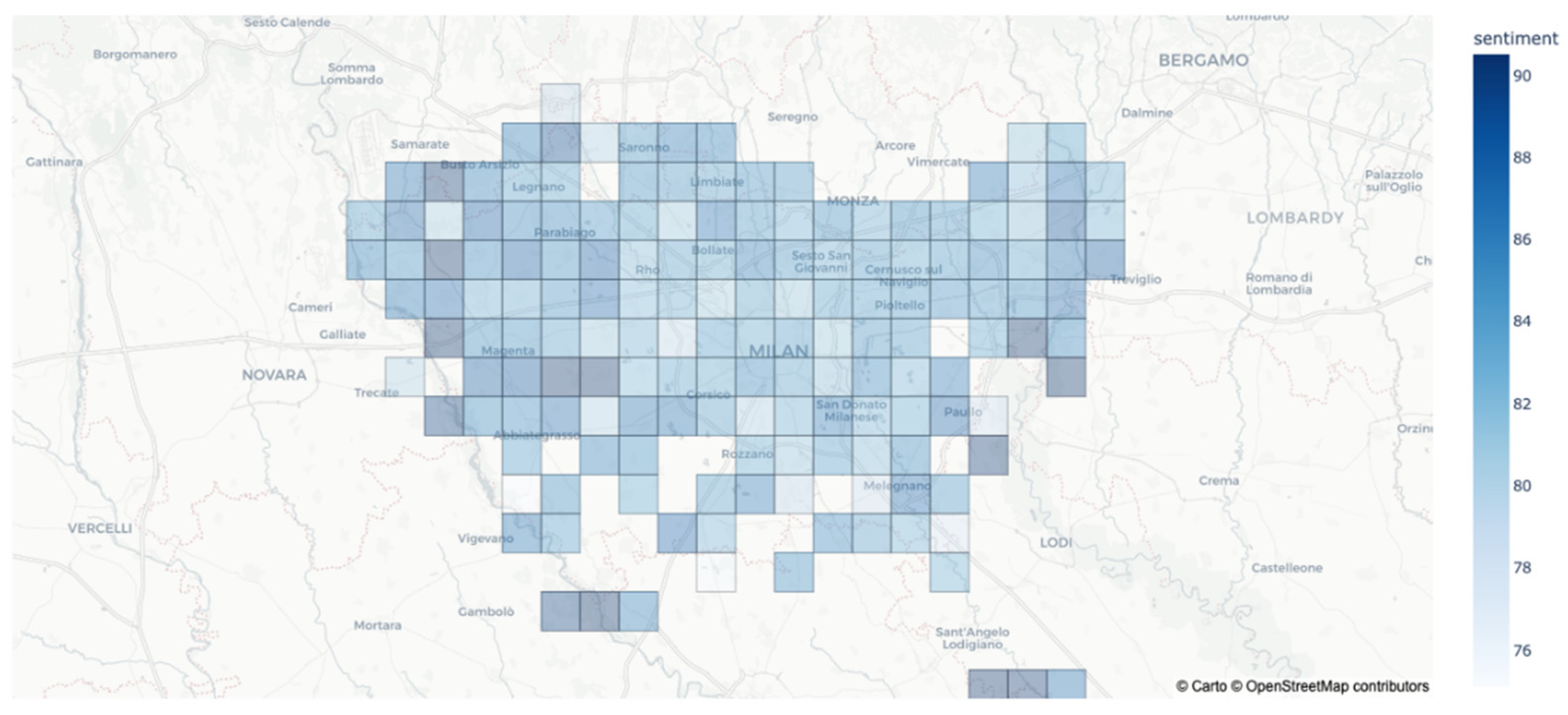
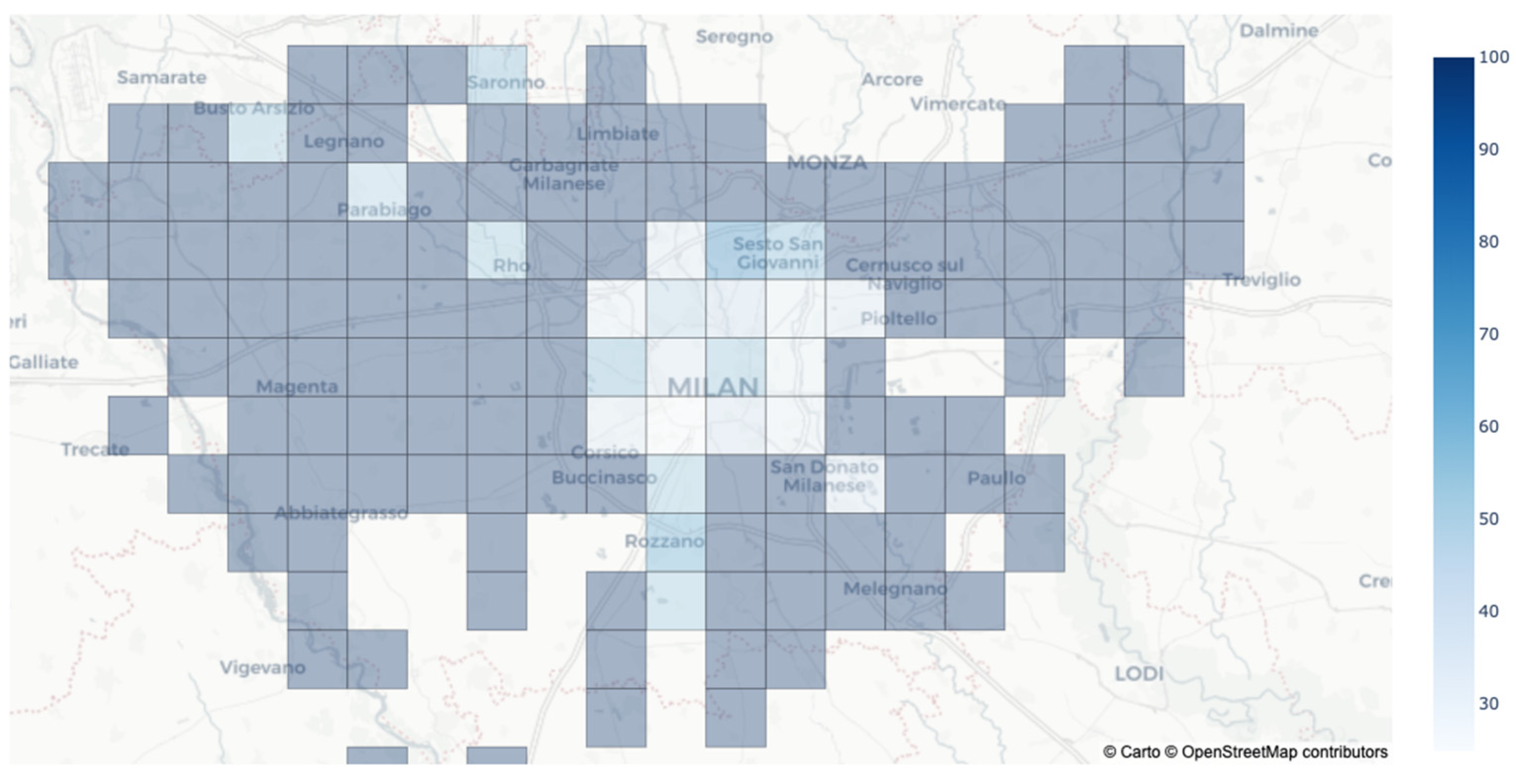
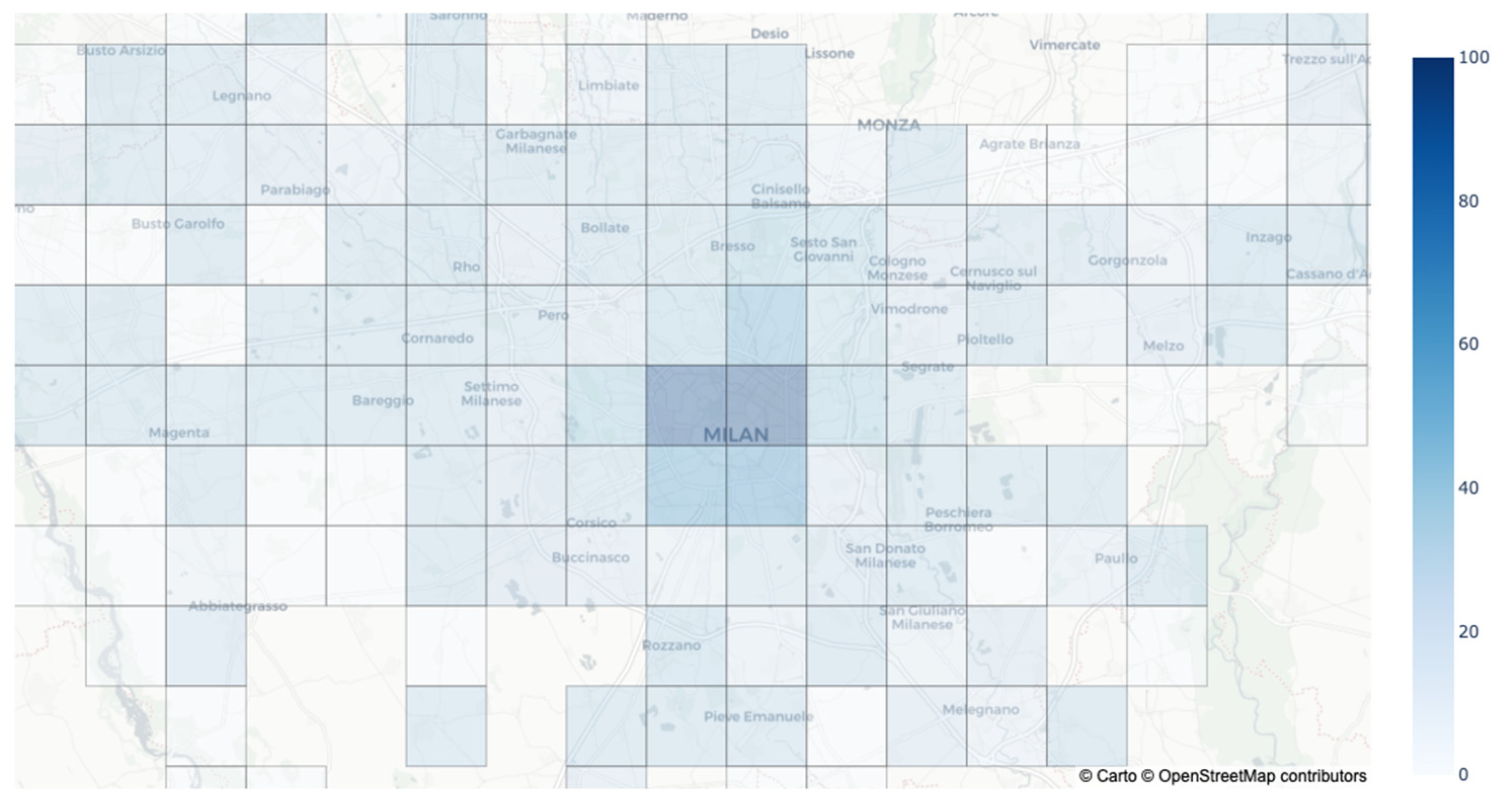
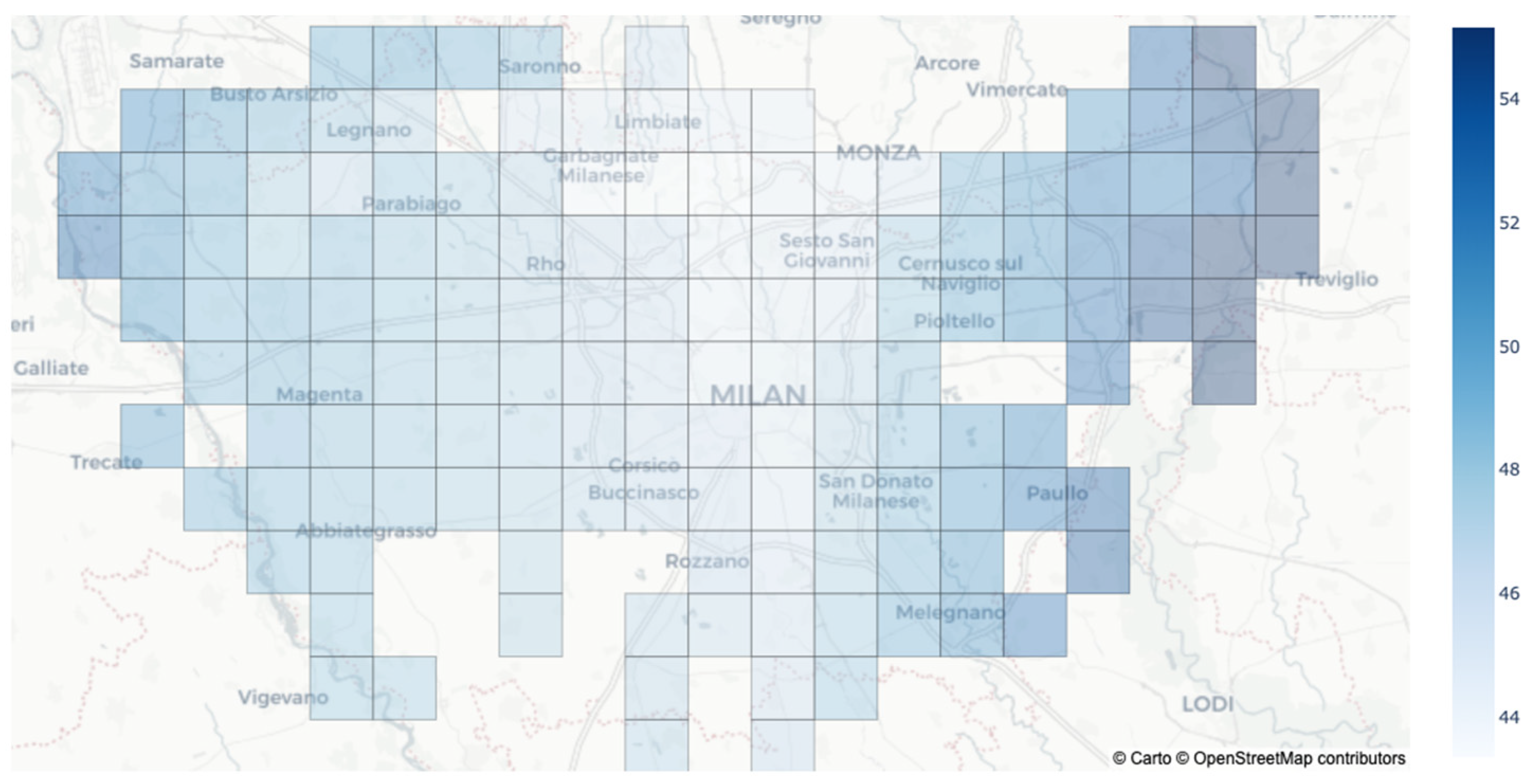
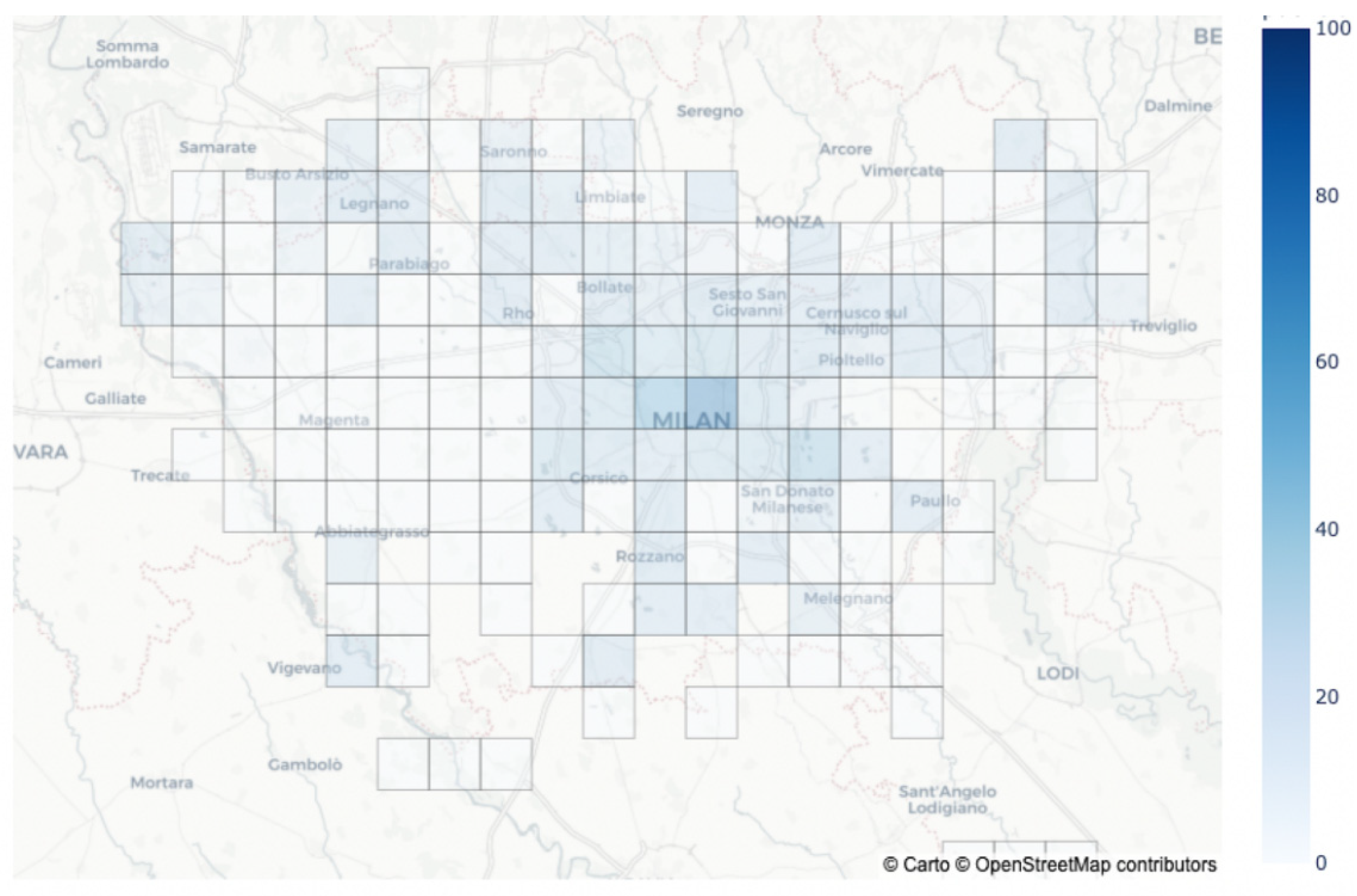
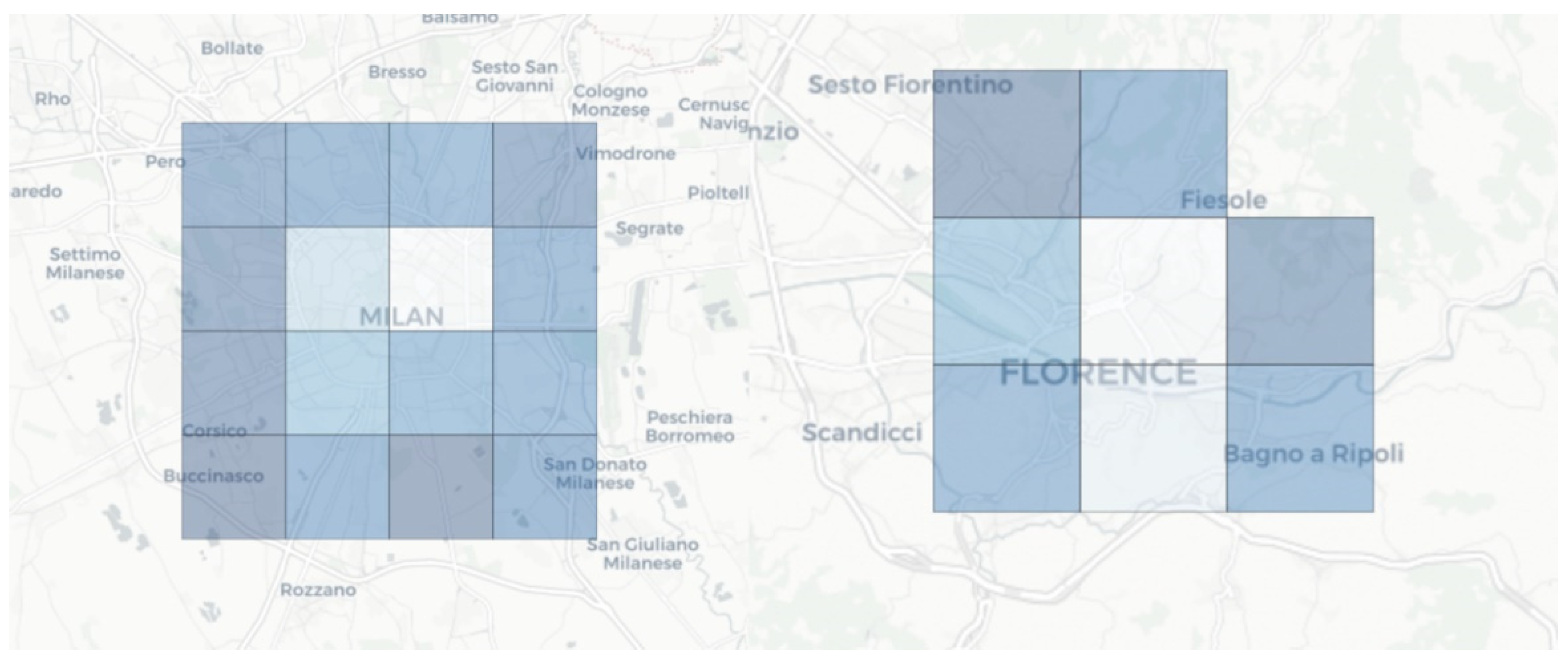
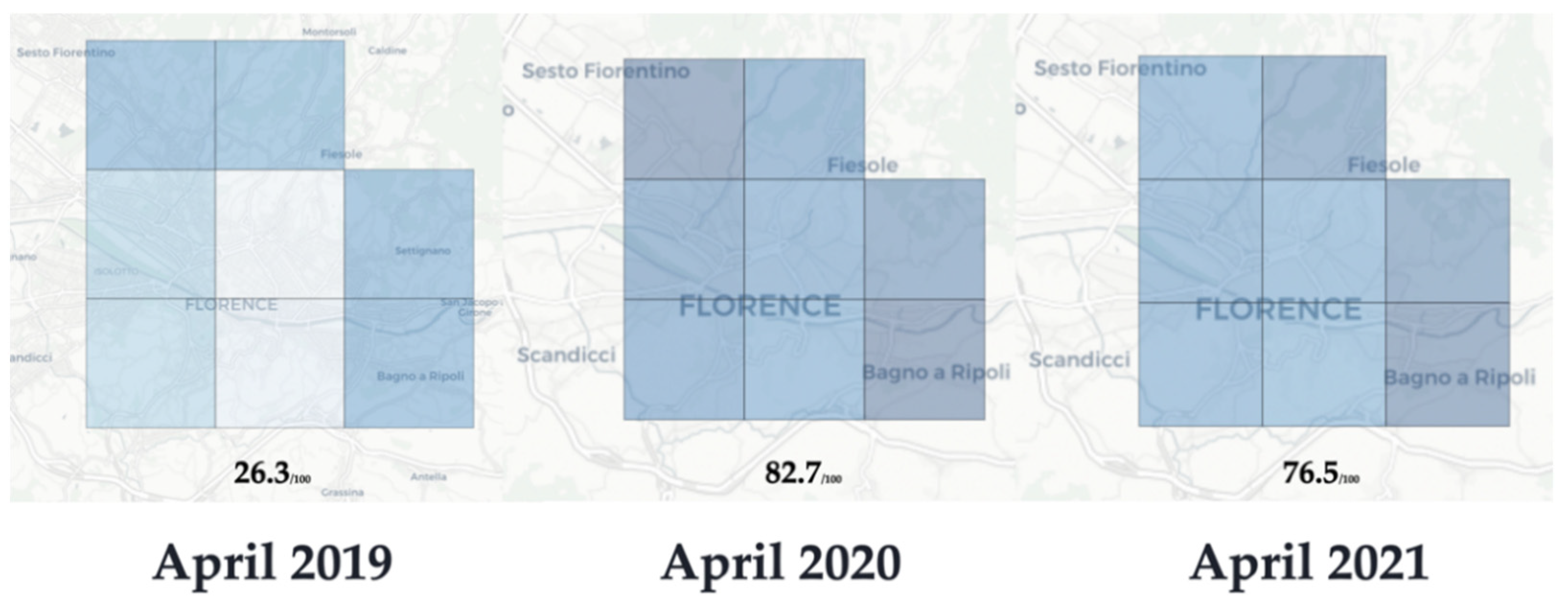

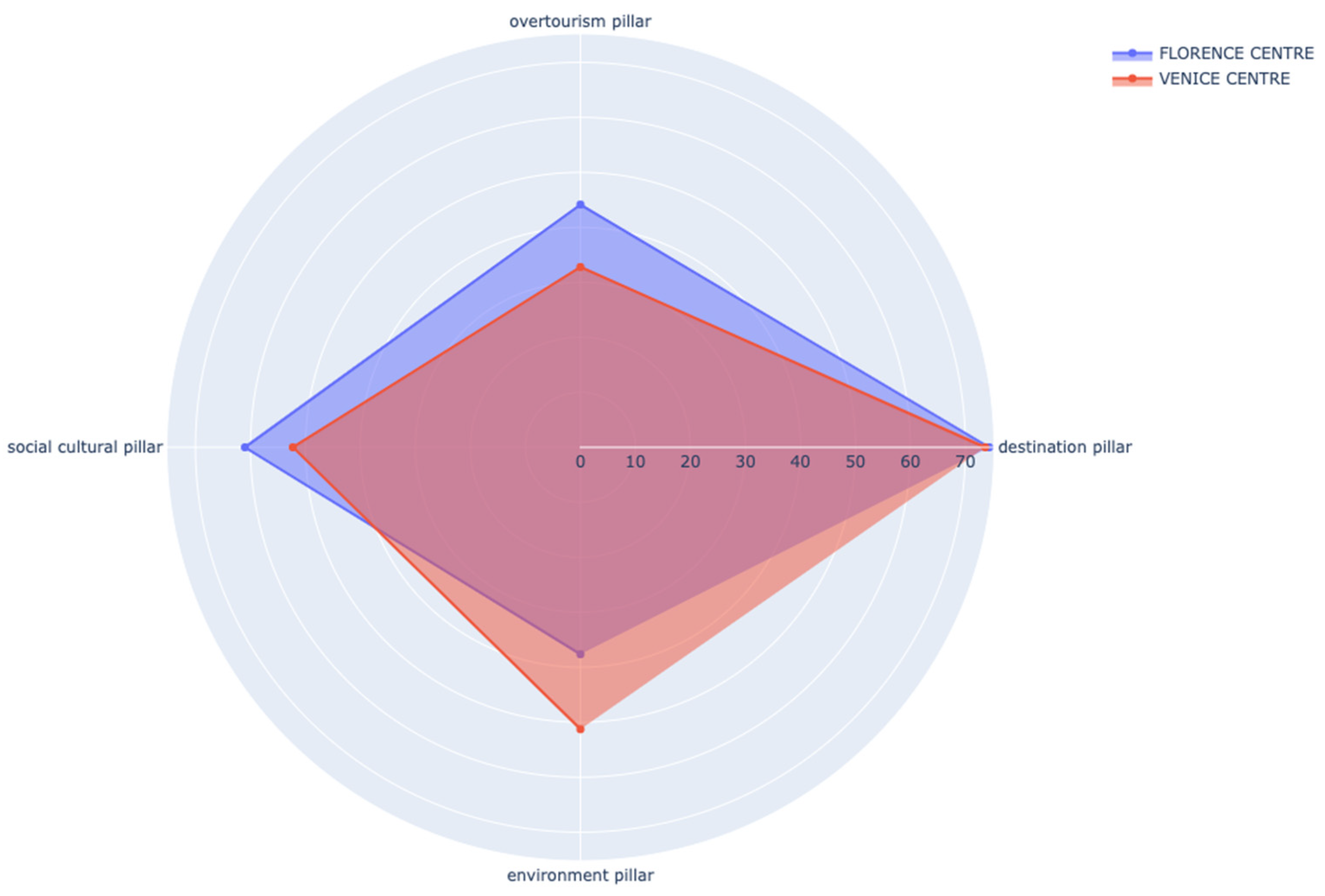

| ETIS Criteria Reference | TSI Sub-Indicators | Sentiment Analysis | Data Source |
|---|---|---|---|
| A.2 Customer satisfaction | Customer Satisfaction Index | Yes | Proprietary data |
| Short-Term Confidence | Yes | Proprietary data | |
| B.1 Tourism flow at destination | Seasonality Balance | Yes | Proprietary data |
| Volume of Visitors | No | Proprietary data | |
| Percentage of Business Tourism | No | Proprietary data | |
| B.2 Tourism enterprise(s) performance | OTA Penetration | No | Proprietary data |
| C.1 Community/social impact | Activity of Short-Term Rentals | Yes | Proprietary data |
| Tourism Pressure | No | Proprietary and open data | |
| Tourism Supply Pressure | No | Proprietary and open data | |
| C.2 Health and safety | Good Health Index | Yes | Proprietary data |
| C.4 Inclusion/accessibility | Accessibility Index | No | Proprietary data |
| C.5 Protecting and enhancing cultural heritage, local identity, and assets | Cultural Index | Yes | Proprietary data |
| Urban Green Index | Yes | Proprietary data | |
| D.1 Reducing transport impact | Public Transportation Accessibility | Yes | Proprietary data |
| D.2 Climate change | CO2 Index | No | Open data |
| Air Quality Index | No | Open data | |
| Sea Quality Index | No | Open data | |
| D.7 Landscape and biodiversity protection | Natural Coverage | No | Open data |
Publisher’s Note: MDPI stays neutral with regard to jurisdictional claims in published maps and institutional affiliations. |
© 2022 by the authors. Licensee MDPI, Basel, Switzerland. This article is an open access article distributed under the terms and conditions of the Creative Commons Attribution (CC BY) license (https://creativecommons.org/licenses/by/4.0/).
Share and Cite
De Marchi, D.; Becarelli, R.; Di Sarli, L. Tourism Sustainability Index: Measuring Tourism Sustainability Based on the ETIS Toolkit, by Exploring Tourist Satisfaction via Sentiment Analysis. Sustainability 2022, 14, 8049. https://doi.org/10.3390/su14138049
De Marchi D, Becarelli R, Di Sarli L. Tourism Sustainability Index: Measuring Tourism Sustainability Based on the ETIS Toolkit, by Exploring Tourist Satisfaction via Sentiment Analysis. Sustainability. 2022; 14(13):8049. https://doi.org/10.3390/su14138049
Chicago/Turabian StyleDe Marchi, Damiano, Rudy Becarelli, and Leonardo Di Sarli. 2022. "Tourism Sustainability Index: Measuring Tourism Sustainability Based on the ETIS Toolkit, by Exploring Tourist Satisfaction via Sentiment Analysis" Sustainability 14, no. 13: 8049. https://doi.org/10.3390/su14138049
APA StyleDe Marchi, D., Becarelli, R., & Di Sarli, L. (2022). Tourism Sustainability Index: Measuring Tourism Sustainability Based on the ETIS Toolkit, by Exploring Tourist Satisfaction via Sentiment Analysis. Sustainability, 14(13), 8049. https://doi.org/10.3390/su14138049








